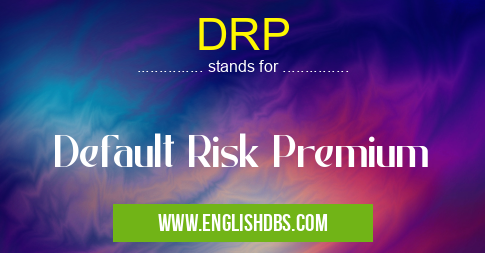What does DRP mean in UNCLASSIFIED
DRP stands for Default Risk Premium. It is a component of bond pricing that compensates investors for the risk of default by the bond issuer. Default risk refers to the possibility that the bond issuer may fail to make timely interest payments or repay the principal amount on the bond's maturity date.

DRP meaning in Unclassified in Miscellaneous
DRP mostly used in an acronym Unclassified in Category Miscellaneous that means Default Risk Premium
Shorthand: DRP,
Full Form: Default Risk Premium
For more information of "Default Risk Premium", see the section below.
Calculation of DRP
The DRP is typically calculated using historical data and statistical models. It is estimated by assessing the issuer's financial strength, credit history, industry performance, and overall economic conditions. The higher the perceived risk of default, the higher the DRP will be.
Importance of DRP
The DRP plays a crucial role in determining the yield to maturity (YTM) of a bond. The YTM reflects the total return an investor can expect to earn by holding the bond until its maturity date. The higher the DRP, the higher the YTM will be, as investors demand a higher return to compensate for the increased risk of default.
Impact on Bond Pricing
Bonds with higher DRPs are considered riskier and, therefore, trade at lower prices than bonds with lower DRPs. Investors are willing to pay a premium for bonds with lower DRPs because they offer a lower risk of default.
Essential Questions and Answers on Default Risk Premium in "MISCELLANEOUS»UNFILED"
What is the Default Risk Premium (DRP)?
The Default Risk Premium (DRP) is a component of the yield spread, which represents the excess return required by investors for holding bonds issued by risky borrowers. It compensates investors for the higher probability that the bond issuer may default on its debt obligations.
How is DRP calculated?
DRP is calculated as the difference between the yield on a risky bond and a risk-free bond with a similar maturity. The risk-free bond typically represents the yield on government-issued bonds, which are considered highly secure.
Why is DRP important?
DRP is important because it reflects the level of risk associated with a particular bond issuer. A higher DRP indicates a greater perceived risk of default, which leads to a higher required return for investors.
What factors influence DRP?
Factors that can influence DRP include:
- Creditworthiness of the bond issuer
- Debt-to-equity ratio
- Cash flow stability
- Industry outlook
- Economic conditions
How does DRP affect bond prices?
A higher DRP results in a lower bond price. This is because investors demand a higher return for bearing the increased risk of default. As a result, issuers with a higher DRP may have to pay a higher interest rate on their bonds to attract investors.
Final Words: The DRP is an important factor to consider when evaluating the risk and return of a bond investment. It provides investors with an estimate of the potential risk of default and helps them make informed decisions about their investments. Understanding the concept of DRP is essential for both individual investors and financial professionals involved in bond markets.
DRP also stands for: |
|
| All stands for DRP |
